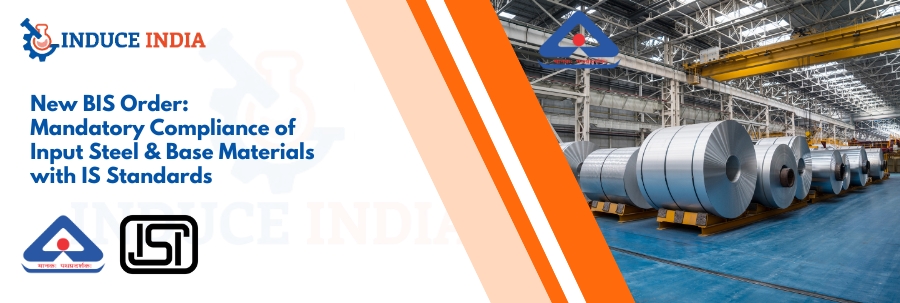Recently, the Bureau of Indian Standards (BIS) announced a new regulatory order that will change the way in which steel products are certified in India. So far, BIS certification has mainly concentrated on making sure that the finished product is per the required Indian Standards (IS). But according to the new directive, it is not sufficient that the finished item only passes the quality test. This time onwards, the input steel and base materials being used in the manufacturing process also need to be fully adherent to the applicable IS codes.
This measure might seem a minor administrative adjustment, but in practice, it leaves an enormous dent in the steel business. It not only deals with the old problem of poor traceability and quality control loopholes, but also prevents the entry of low-quality or cheap steel into the Indian market. More significantly, it makes sure that steel applied in building, cars, infrastructure, and other critical areas is tough, dependable, and of persistent quality. This development is seen by us at Induce India as a strong opportunity to give businesses a chance to create credibility, to maintain international standards and ensure consumer trust by adhering to rules.
Why the New Order Was Needed
Modern economic infrastructure and everyday civilisation depend on the steel industry as it provides the construction materials necessary to build buildings, bridges, factories, and machinery, as well as the goods we use every day. The daily safety, performance, and durability of life depend on the insurmountable quality and safety of steel and the constant threat of its compromise. While product-based BIS standards for finished goods have, over the years and to an extent, managed to enforce quality assurance, they continue to neglect the regulation of the raw materials used in their production.
Sealing the Traceability Gap
Think about a situation where a steel bar is certified by BIS due to passing the strength and bend test during the final phase of manufacturing. But suppose the billets or slabs on which that bar was made were of bad quality? In this situation, the end product might look as if it has passed trial at first, but might not be able to hold up under stress conditions in the real world, endangering both lives and projects. It is this loophole that the new BIS order tries to remedy. The system has made a chain of responsibility that begins at the first stage of the steel production process, all the way to the final product, because certification of final products is done based on the compliance of input materials.
Providing a Level Playing Field
The domestic manufacturers in India were already using the IS standards on their raw materials several years ago, which added to their production costs. The same stringent checks, however, did not apply to imported finished goods, and they could compete unfairly in the Indian market. This made the playing field unequal as local businesses, at times, were undercut by foreign producers who were selling cheaper and lower-quality items. The new order corrects this imbalance. This means that now the steel made anywhere, be it in India or elsewhere, the input as well as the end product must be of Indian Standards.
Safeguarding Against Low-end Imports
The other significant motive that necessitates the establishment of this order is the risk of international steel dumping. The global market is usually dominated by surplus supply, and this tends to force some nations to offer cheap and poor-quality steel. Devoid of stringent rules, India may turn into a dumping ground for such material. This is not only damaging domestic producers but also jeopardising safety in construction and industry. Under the BIS requirement, India has constructed a wall of protection that only certified and standard-compliant steel gets into its supply chain.
What Exactly Has Changed
The BIS notification does not simply say that the inputs should be compliant; it also gives a step-by-step mapping of what input IS codes should be associated with what final product IS codes. This transparency eliminates many types of ambiguity among manufacturers and leaves no space to take shortcuts.
Product-Input Mapping
This mapping basically implies that all the manufacturers who seek to have their final product certified by BIS also have to prove that the raw material or input steel that was used in the manufacturing process is of BIS-certified origin. As an example, the reinforcement bars, galvanized sheets, pressure vessel plates, as well as pre-painted sheets also have the input standards attached to them. This will ensure compliance is not confined to the final product but is firmly entrenched in the entire manufacturing process.
Some examples of Compliance Mapping
To be more specific, we can use some examples:
- Reinforcement Bars (IS 1786:2008) are very common in construction. These bars are to be made of billets, ingots, or slabs that are IS 14650:2023 compliant. This makes sure that the bars are strong at the centre.
- Galvanized Sheets (IS 277:2018) shall rely on substrates that conform to IS 513, IS 1079, IS 2062, or IS 5986 standards. This ensures that the sheet contains not only a long-lasting coating, but also a high base steel.
- Pre-painted Sheets (IS 14246: 2024) now have galvanised inputs that are compliant with IS 277: 2018 and have better performance in roofing and cladding.
These illustrations show that the mapping prevents any gaps, leaving no room through which inferior steel can pass.
Who Needs to Comply
This is not an order happening in a single section of the industry- it is the order that happens in the entire steel ecosystem, including the producers of the raw material, the manufacturers and importers of the final product.
-
Final Product manufacturers
Manufacturers of bars, rods, strips, pipes, wires and coated products have to demonstrate to BIS authorities that they have procured their raw materials with IS-compliant suppliers. Only when both the stages, input and output, are compliant, certification will be granted.
-
Primary Steel Producers
The steelmakers that manufacture billets, blooms, slabs, and hot-rolled products are also affected. They also have to find a way to ensure compliance because their outputs are the inputs of other manufacturers. This is what makes their contribution very crucial to the integrity of the entire supply chain.
-
Importers and Traders
In the case of importers, the burden is still greater. Customs authorities will now examine imports of steel (raw or finished) to ensure that they have documentation that will prove compliance with IS. Any shipments that pass such checks face detention, rejection or penalties. This will not allow imported steel to circumvent the system.
What Compliance Actually Means In Practice
Under the new BIS framework, compliance is not an option, but by law. Nevertheless, it will be impossible without some modifications in the sourcing, documentation, and inspection practices by companies.
-
Input Source Only IS-Compliant
The first measure is to purchase raw materials only from suppliers bearing a valid BIS certification. Manufacturers will no longer afford to purchase cheaper non-compliant materials, as this will render their final product illegal.
-
Record and keep Records
All consignments now have to include test certificates and mill records. The heat numbers, batch records and inspection reports should state clearly that the inputs are of an IS standard. These records are used as evidence when conducting audits by BIS and clearing of customs clearance.
-
Update Quality Systems
The input compliance checks should be incorporated into the incoming inspection and quality control systems adopted by manufacturers. As an example, prior to rolling billets into bars, they should ensure that billets meet the chemical and mechanical properties required as specified in the IS codes.
-
Rewrite Procurement and Contracts
Procurement teams need to revise the purchase order to add a compulsory ground where suppliers need to deliver material that is IS compliant. This minimises the chances of conflicts in future.
Elaborations and Conclusions
The new BIS order is very strict, but the authorities have clarified and provided some temporary exemptions so that the adoption becomes easy.
-
Not a New QCO
The Ministry of Steel made it clear that this is not a fresh Quality Control Order but a clarification of the current BIS regime. It merely makes sure that the purpose of BIS standards is both input and output.
-
Customs Enforcement
Since June 2025, customs officers have begun to check compliance not only with raw materials but also with finished products in ports. Shipments that fail to comply are now dealt with sternly, with rejections and penalties.
-
Transitional Exemptions
-
- Importers are given time to settle, as shipments which are dated before July 15, 2025, will not be subject to the Bills of Lading.
- Steel end-to-end facilities known as Integrated Steel Plants (ISPs) might be exempted on the condition that they fulfil the ministry requirements.
Industry-Wide Implications
The order has far-reaching effects in the various segments of the steel industry. Although it comes with new compliance costs, the long-term gains are enormous.
-
Stronger Quality Assurance
In the case of infrastructural projects such as highways, bridges, and metros, this order requires the use of only high-quality steel. This will have a direct positive impact on safety and minimise structural failure risks.
-
Impact on MSMEs
Micro, small and medium enterprises tend to have tight budgets. In their case, the cost of procuring BIS-compliant inputs and documentation may be an issue. This is where professional consultancy services will be critical to provide seamless compliance without interrupting the business.
-
Domestic Industry Protection.
The government has provided Indian manufacturers with a reasonable opportunity to compete by imposing the same rules on imports. This safeguards employment, investments and stability of the home steel industry.
How does Induce India help Businesses?
At Induce India, we understand that the entry into new compliance structures can be daunting to manufacturers and importers. This is the reason why we will offer full end-to-end services to companies that will adjust to the new BIS order.
- Gap Assessment: We evaluate your current sourcing, documentation and production procedures to determine non-compliance with the new requirements.
- Supplier Compliance Checks: Our experts ensure your suppliers are BIS-certified and assist you to source sourcing from certified suppliers.
- Preparation of documentation and audit: Induce India assists you in developing effective traceability systems, enabling every input to be easily traced to your end product. We also train your crews on BIS checks, eliminating the probability of being rejected.
- Import Advisory: In the case of importers, our consultancy helps you with the correct paperwork to clear customs. This will help avoid delays, fines and consignments being rejected.
Conclusion
The new BIS order is a step in the right direction for the steel industry in India. It provides a more robust and less risky ecosystem of infrastructure and production as it ensures the compliance of both input substances and end products. Though companies may incur some issues initially to adapt, their benefits in the long run in terms of quality, safety and competitiveness in the global market cannot be overlooked.
In the case of companies, the trick is to be proactive with compliance. When you have the right partner, compliance does not weigh you down but becomes a strategic benefit. We at Induce India are your reliable partner in this journey- to facilitate you through the complexities, fulfil all criteria, and even enhance your market stance with BIS certification.



